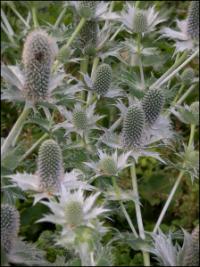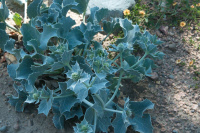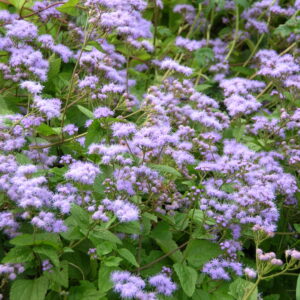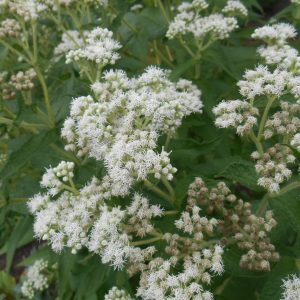Perennials & Biennials
Showing 177–184 of 511 results
-
Eryngium giganteum Miss Wilmott’s ghost SELF-SEEDING BIENNIAL Z 5-8
In summer, oval thistles top prickly green, turning steely blue, silvery, bracts – very ornamental.
In summer, oval thistles top prickly green, turning steely blue, silvery, bracts – very ornamental.
Size: 36" x 24"
Care: Full sun in moist well-drained, fertile soil. Be sure to let it drop its seeds & do not weed seedlings out the following spring.
Native: Caucasus Mountains
Awards: England's Royal Horticultural Society Award of Merit.Eryngium is Greek for thistle. Introduced to England in 1820. Miss Ellen Willmott (1858-1934), a wealthy, eccentric English gardener reputedly dropped seeds as she passed her neighbors’ gardens. The plants came up afterwards, her “ghosts.” Recommended by Gertrude Jekyll in 1908.
-
Eryngium maritimum Sea holly Z 5-10
Round thistles turning steely blue in July-August atop silver colored, prickly bracts. Attractive ivy-shaped prickly foliage.
OUT OF STOCK
Round thistles turning steely blue in July-August atop silver colored, prickly bracts. Attractive ivy-shaped prickly foliage.
Size: 12" x 10" slowly spreads
Care: Full sun in well-drained soil.
Native: Seacoasts of Europe“Eryngium” is Greek for thistle. Anglo-Saxons prescribed Sea holly root to cure the king’s evil, serpent bites, broken bones, stiff necks and melancholy. Also considered an aphrodisiac and brought on “kissing comfits.” This was identified by Dioscorides in De Materica Medica for medicinal use around 70 A.D. Eryngium was described in Gerard’s Herball in 1597 for its uses:” old and aged people that are consumed and withered with age, and which want natural moisture (and also) amended the defects of nature in the younger,” William Robinson, father of the mixed perennial border, considered this plant “very pretty.”
-
Eryngium planum Flat sea holly Z 5-9
Round thistles top prickly steel blue, silver colored, bracts June-August. Stems turn steel blue too. Deadhead for repeat bloom. Reseeds readily. Great cut flowers: dry or fresh…
Round thistles top prickly steel blue, silver colored, bracts June-August. Stems turn steel blue too. Deadhead for repeat bloom. Reseeds readily. Great cut flowers: dry or fresh.
Size: 36” x 18”
Care: Sun well-drained soil, drought tolerant
Native: E. EuropeEryngium is Greek meaning “thistle.” Described in Gerard’s Herball in 1597 for its uses to remedy: “old and aged people that are consumed and withered with age, and which want natural moisture (and also) amended the defects of nature in the younger.”
-
Eryngium yuccifolium Rattlesnake master Z 3-8
Blooms July-December, prickly round white umbels. Leaves like thinner versions of a Yucca.
Blooms July-December, prickly round white umbels. Leaves like thinner versions of a Yucca.
Size: 48” x 18”
Care: Full sun, moist well-drained soil
Native: Eastern United States, Wisconsin native
Wildlife Value: Supports over 40 bee species.
Awards: Missouri Botanic Garden Plant of Merit.Eryngium is Greek meaning “thistle.” The name “Rattlesnake master” comes from the use by Chickasaw shamans of chewing the root, blowing it on the hands and then picking up rattlers without injury or “from its virtues of curing the bite of that venomous reptile.” Gardeners’ Dictionary, 1768. Valued by Native Americans for medicinal uses: a diuretic, stimulant, and cure for venereal disease and impotence, purify blood; Chippewa for joint inflammation and strengthen young children and Cherokee as a toothache remedy; Sioux: Root cured bladder ailments, and rattlesnake bites and scorpion stings. A concentration of boiled root increased virility of Sioux men. The Forest Potawatomi used Rattlesnake master as a good luck charm – the top placed in a pocket made the gambler sure to win. Collected in Virginia by Rev. John Banister (1649-1692) who moved to colonial Virginia in 1678. A gunman mistakenly shot and killed him while he collected plants.
-
Erythronium americanum Yellow trout lily, Dog’s tooth violet Z 3-9
Downfacing yellow lily-like recurved flowers in spring above mottled foliage. Tops of petals slightly tan Grows from deep rootstock or corm, 3-5” deep. In time it spreads from offshoots of the corm, resulting in colonies of trout lilies. Ephemeral – dies back in summer.
OUT OF STOCK – Only available for purchase in spring.
Downfacing yellow lily-like recurved flowers in spring above mottled foliage. Tops of petals slightly tan Grows from deep rootstock or corm, 3-5” deep. In time it spreads from offshoots of the corm, resulting in colonies of trout lilies. Ephemeral – dies back in summer.
Size: 3-6” x 4”
Care: part to full shade in moist soil
Native: Eastern No. America, WisconsinCherokee warmed crushed leaves & poured the juice over wounds. According to Cherokee Yellow trout lily also remedied fever, fainting & removed slivers. Used by Iroquois as birth control for young women and to make fish bite (by chewing the root & spitting into the river.) In garden cultivation since 1665. Named Dog’s tooth because the white, oblong, fleshy root is shaped like a dog’s tooth.
-
Eupatorium coelestinum album syn Conoclinium coelestinum ‘Album’ Mistflower ‘Album’ Z 3-7
Clusters of white in fall –close looks like a mophead of many strings, at a distance it looks like a big Ageratum - August to October.
Clusters of white in fall –close looks like a mophead of many strings, at a distance it looks like a big Ageratum – August to October.
Size: 3’ x 2-3’
Care: sun in moist to moist well-drained soil
Native: New Jersey west to Illinois south to Texas and east to Florida
Wildlife Value: attracts bees & butterflies - nectar source for American painted lady butterflyEupatorium named after Mithridates Eupator, ancient king of Pontus, Greece, said by Pliny to have used another species of Eupatorium medicinally in 1st century B.C. ‘Album’ first described and named in 1940.
-
Eupatorium coelestinum syn. Conoclinium coelestinum, Coelestina ageratoides Blue mist Z 3-7
Clusters of cornflower blue in fall –close looks like a mophead of many strings, at a distance it looks like a big Ageratum - August to October.
Clusters of cornflower blue in fall –close looks like a mophead of many strings, at a distance it looks like a big Ageratum – August to October.
Size: 3' x 2-3'
Care: full sun in moist to moist well-drained soil.
Native: New Jersey west to Illinois south to Texas and east to Florida
Wildlife Value: nectar source for many butterflies and both nectar and pollen for many beesEupatorium named after Mithridates Eupator, ancient king of Pontus, Greece, said by Pliny to have used another species of Eupatorium medicinally in 1st century B.C. This species 1st collected by Quaker planthunter and nursery owner John Bartram (1699-1777) in 1732 and offered for sale in Bartram Garden’s 1783 Broadside, America’s 1st plant catalog.
-
Eupatorium perfoliatum Boneset, Thoroughwort Z 4-8
Frilly white clusters atop 3’ tall stems brighten the garden July to September
Frilly white clusters atop 3’ tall stems brighten the garden July to September
Size: 4’ x 2-3’
Care: sun to part shade in moist to moist well-drained soil
Native: Maine to Florida west to Texas and north to Dakotas, Wisconsin native
Wildlife Value: Host for caterpillars of Lost Meadowlark butterflies. Nectar and/or pollen for numerous bees, butterflies, and wasps. Resistant to deer and rabbits.Named “boneset” because it was used to treat breakbone fever in 1800’s. Winnebago steeped it in a tea to cause sweating and stop fever. Sent to England in 1699. Grown in America’s 1st botanic garden Elgin botanic Garden in 1811.








